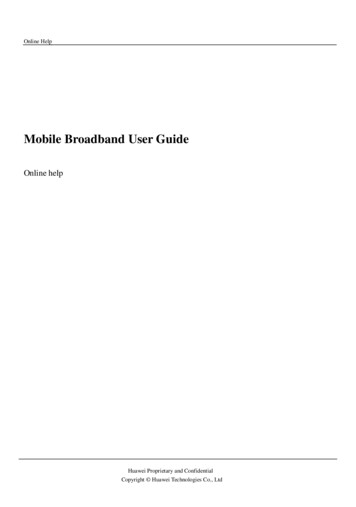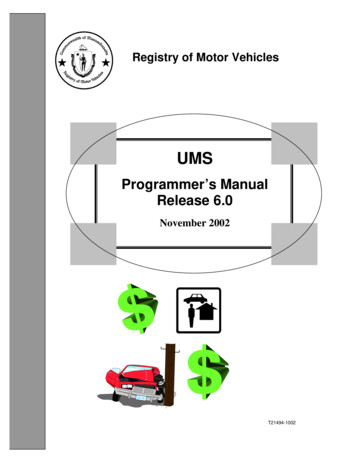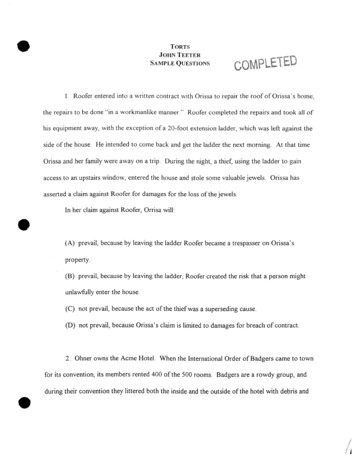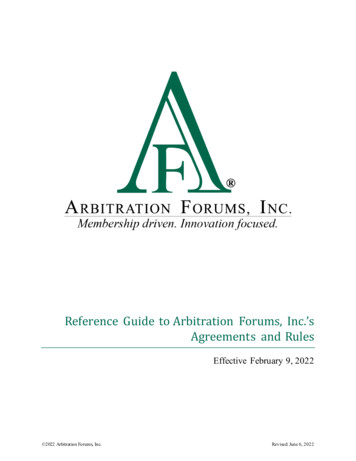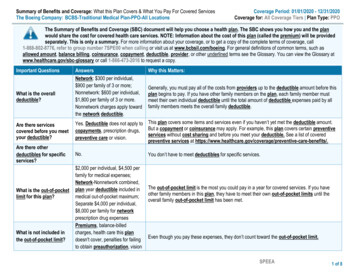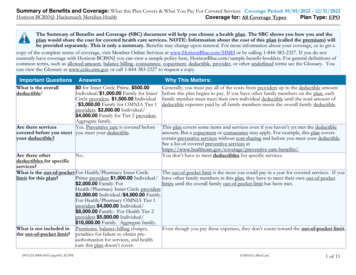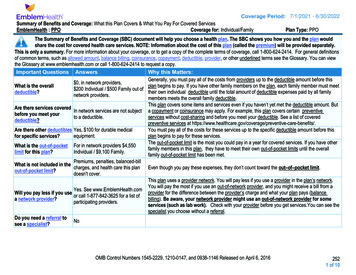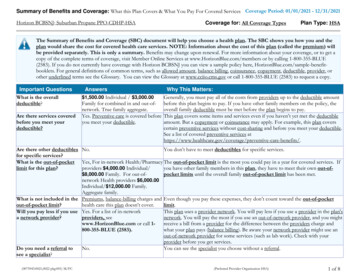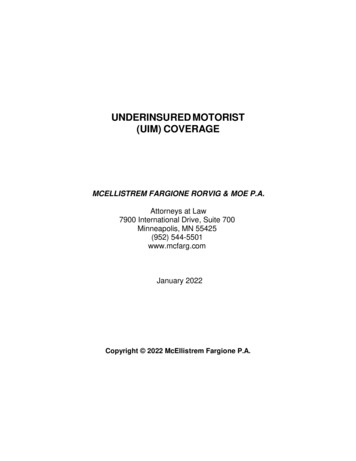
Transcription
UNDERINSURED MOTORIST(UIM) COVERAGEMCELLISTREM FARGIONE RORVIG & MOE P.A.Attorneys at Law7900 International Drive, Suite 700Minneapolis, MN 55425(952) 544-5501www.mcfarg.comJanuary 2022Copyright 2022 McEllistrem Fargione P.A.
TABLE OF CONTENTSI.A.B.II.UIM Statutory Background . 1Present Law. 1Historical Background . 11. 1972 - 1974 . 12. 1975 - April 12, 1980 . 23. April 12, 1980 - October 1, 1985 . 24. October 1, 1985 - August 1, 1989 . 25. August 1, 1989 - present. 2What is an Underinsured Motor Vehicle? . 3A. Applicable Definition of Underinsured Motor Vehicle . 31. Motor Vehicle . 32. Motorcycle. 4B. Meaning of “Underinsured” . 41. Actual Damages and Percentage of Fault . 52. Liability Coverage. 53. Liability Coverage Dispute . 6III.A.B.Exclusions. 8Statute . 8Contract . 81. Myers Exclusion . 82. Family Exclusion . 103. Other Exclusions – Business Use . 12IV.A.UIM Priorities: Which Company Pays? . 14Minn. Stat. § 65B.49, subd. 3a(5) . 141. Meaning of “Occupying” . 142. Meaning of an “Insured” . 15B. Motorcycle Coverage . 17C. Excess Coverage. 181. Myers Exclusion . 192. Multiple Claimants. 19D. Coverage by Multiple Policies. 20V.A.B.VI.A.B.The Amount of UIM Coverage . 23Add-On Coverage. 23Stacking . 23First Step in UIM Claim: Resolve the Liability Claim . 25Nordstrom Analysis . 25Resolution by Verdict. 251. Notice of Suit to UIM Insurer . 25Underinsured Motorist(UIM) CoveragePage i
2. Participation of UIM Insurer in Liability Trial . 253. Effect of Jury Award . 264. Effect of Arbitration Award Against the Tortfeasor . 26C. Resolution by Settlement. 281. Prior Notice to UIM Insurer(s) . 282. Content of Notice . 283. Purpose of Notice . 294. Requirement of “Best Settlement” . 295. Effect of No Notice . 306. Drake v Ryan settlements may waive UIM claims . 317. What Companies Must Receive Notice. 318. UIM Insurer’s Options After Receiving Notice . 319. Risks Faced by Insurance Company that Substitutes Draft . 32VII.A.B.Options If UIM Insurer Substituted Draft . 34Normal Procedure: Pursue the UIM Claim. 34Claimant’s Option to Pursue Tortfeasor. 34VIII.A.Amount of UIM Claim . 35Damages . 351. Generally. 352. Consortium Claims. 353. Interest . 35B. Deductions. 351. Comparative Fault. 352. Liability Payments . 363. No-Fault Payments . 374. Collateral Sources. 37a. Statute . 37IX.A.B.X.Multiple Parties . 40Multiple Claimants . 40Multiple Defendants . 40UIM Insurer’s Right of Recovery . 43A. Subrogation Against the Underinsured Driver . 43B. Subrogation Against Other Tortfeasors . 44C. Contribution Claims . 44XI.A.Statute of Limitations . 45Claims Against UIM Insurer . 451. Mandatory Arbitration . 452. Contracts with Shorter Statutes of Limitation . 45B. Subrogation Claims by UIM Insurer . 46XII.Effect of UIM Payment on Subsequent No-Fault Claims . 47Underinsured Motorist(UIM) CoveragePage ii
I.UIM Statutory BackgroundA.Present LawMotor vehicle insurance policies issued for motor vehicles in Minnesota must provideunderinsured motorist (UIM) coverage. Minn. Stat. § 65B.49, subd. 3a. However, UIMinsurance coverage is not mandated for motorcycles.The statute explicitly allows an insurance company to sell UIM coverage that is broader inscope than the coverage required by the No-Fault Act. Minn. Stat. § 65B.49, subd. 7.Consequently, it is essential to review the terms of the applicable UIM contract when closeissues are being resolved.B.Historical BackgroundIt is important to know some of the historical background of UIM coverage in order todetermine which of the past Minnesota Supreme Court decisions have been superseded bystatutory changes.1972-1974 Required UIMcoverage to be“made available” UIM provided“difference oflimits” coverage Applicable statute:Minn. Stat.§65B.251.1975-19801980-1985 Insurers required to No mention of UIMoffer optional UIMcoverage incoverageMinnesota statutes Changed from“difference oflimits” coverage to“add on” or“excess” coverage Applicable statute:Minn. Stat.§65B.49, subd.6(e)1985-19891989 to present Made UIMcoverage a singlecoveragecombined withuninsured motorist(UM) coverage Changed back to“difference inlimits” coverage Applicable statute:Minn. Stat.§65B.49, subd. 3a Made UM and UIMseparatemandatorycoverages Once again an“add on” coverage Applicable statute:Minn. Stat.§65B.49, subd. 3aand 4a1972 - 1974Minn. Stat. § 65B.25 required that UIM coverage be “made available” by insurancecompanies. See Jacobson v. Ill. Farmers Ins. Co., 264 N.W.2d 804 (Minn. 1978). UIM wasa “difference of limits” coverage. The UIM coverage actually available to an injured claimantwould be calculated by first deducting liability insurance limits from the UIM limits. Lick v.Dairyland Ins. Co., 258 N.W.2d 791 (Minn. 1977). For example, in a “difference of limits”system, an accident involving a 50,000 liability insurance policy and a 50,000 UIM policywould result in having a total of 50,000 in coverage, with no UIM coverage actuallyavailable to compensate for injuries caused by the accident.Underinsured Motorist(UIM) CoveragePage 1
2.1975 - April 12, 1980On January 1, 1975, the Minnesota No-Fault Act took effect. Insurers were now requiredto offer optional UIM coverage. Minn. Stat. § 65B.49, subd. 6(e). The coverage waschanged from “difference of limits” to an “add on” or “excess” coverage. With an “add on”system, an accident involving a 50,000 liability insurance policy and a 50,000 UIMpolicy would result in having a total of 100,000 in coverage for injuries caused by theaccident.Because the statute required an offer of UIM coverage, the courts would impose UIMcoverage as a matter of law if an insurance company could not show that it had made acommercially reasonable offer of UIM coverage. Holman v. All Nation Ins. Co., 288N.W.2d 244 (1980). In response to Holman, the legislature revised the statute.3.April 12, 1980 - October 1, 1985During this period, Minnesota statutes did not mention UIM coverage. Judicial decisionscontinued to clarify the nature and scope of the coverage. See Sobania v. Integrity Mut.Ins. Co., 371 N.W.2d 197 (Minn. 1985); Sibbert v. State Farm Mut. Auto. Ins. Co., 371N.W.2d 201 (Minn. 1985); Hoeschen v. S.C. Ins. Co., 378 N.W.2d (Minn. 1985); AmcoIns. Co. v. Lang, 420 N.W.2d 895 (Minn. 1988).4.October 1, 1985 - August 1, 1989In 1985 legislative changes, UIM coverage was once again made part of the statutegoverning motor vehicle insurance. During this period, UIM was part of a single combinedcoverage with uninsured motorist (UM) coverage. It was a “difference of limits” coverage.5.August 1, 1989 - presentSince August 1, 1989, UIM coverage has been a separate coverage that must be includedin every Minnesota motor vehicle insurance policy. It is once again an “add on” coverage.Minn. Stat. § 65B.49, subds. 3a and 4a.Underinsured Motorist(UIM) CoveragePage 2
II.What is an Underinsured Motor Vehicle?A.Applicable Definition of Underinsured Motor VehicleThe statute defines “underinsured motor vehicle” to include both motorcycles and motorvehicles. See Minn. Stat. § 65B.43, subd 17. In close cases, the definitions in theapplicable insurance policy must also be reviewed.1.Motor VehicleDefinition: Motor VehicleA motor vehicle is a vehicle with at least four wheels that is designed to be self-propelled for use primarilyon public roads in transporting persons or property, and that is required to be registered under Minn. Stat.Ch. 168. See Minn. Stat. § 65B.43, subd. 2.The definition includes a trailer when the trailer is attached to or being towed by a motorvehicle.Under the statutory definition, a farm tractor would not be a “motor vehicle” since it is notdesigned primarily for use on public roads. Great Am. Ins. Co. v. Golla, 493 N.W.2d 602(Minn. Ct. App. 1992). Close cases may arise focusing on whether or not a vehicle isrequired to be registered under Minn. Stat. Ch. 168. See Anderson v. St. Paul Fire &Marine Ins. Co., 427 N.W.2d 749 (Minn. Ct. App. 1988).In Bell v. State Farm Mut. Auto. Ins. Co., No. C8-96-1704, 1997 WL 40664 (Minn. Ct. App.Feb. 4, 1997), a woman was killed in a collision with a grader that was being used toplow snow. Since the grader was “special mobile equipment” exempt from vehicleregistration requirements, it was not a motor vehicle. There could be no UIM claim.A more general issue exists with respect to certain police or other government vehiclessince many are not required to be registered pursuant to chapter 168. In Mut. Serv. Cas.Ins. Co. v. League of Minn. Cities Ins. Trust 659 N.W.2d 755 (Minn. 2003), the courtenforced a literal reading of Minn. Stat. § 65B.43 subd. 2 and confirmed that a police carwas not a “motor vehicle” within the meaning of the No-Fault Act, since a marked police carwas not required to be registered. Although this decision involved a claim for basiceconomic loss benefits under the No-Fault Act, the same reasoning leads to the conclusionthat these unregistered vehicles would not fall within the statutory definition of anunderinsured motor vehicle.Public buses, although they may in fact not have registered license plates, do remainwithin the statutory definition of “motor vehicle.” State Farm Mut. Auto. Ins. Co. v.Metropolitan Council, 854 N.W.2d 249 (Minn. Ct. App. 2014). See also Cimbura v City ofMinneapolis Special Sch. Dist. No 1, No. A-19-1338, 2020 WL 1130319 (Minn. App. Mach9, 2020, confirming that a school bus falls within the definition of a “motor vehicle.”Even though a marked police car or municipal ambulance would not be defined as a “motorUnderinsured Motorist(UIM) CoveragePage 3
vehicle” in the No-Fault Act, it may still be included within the definition of “motor vehicle” or“underinsured motor vehicle” in a typical motor vehicle insurance contract. As alreadynoted, it is important to review the applicable contract in cases when coverage may not bemandated by statute. For example, certain contracts have provided UM or UIM coveragefor accidents caused by farm vehicles or other off-road equipment (which are not “motorvehicles” under the statutory definition) because the accident occurred on a public road.Kashmark v. Western Ins. Co., 344 N.W.2d 844 (Minn. 1984). Such contractual coverage isenforceable, even though not mandated by the provisions of the No-Fault Act.In Ronning v. Citizen’s Sec. Mut. Ins. Co., 557 N.W.2d 363 (Minn. Ct. App. 1996), the courtinvalidated a policy provision that attempted to exclude all government vehicles fromunderinsured coverage. This decision remains valid, since the policy exclusion at issue inRonning is too broad to be consistent with the No-Fault Act.2.MotorcycleDefinition: MotorcycleA motorcycle is a self-propelled vehicle with fewer than four wheels and an engine of more than fivehorsepower. See Minn. Stat. § 65B.43, subd. 13.The No-Fault Act defines “motorcycle” at Minn. Stat. § 65B.43, subd 13. (The definitiondiffers somewhat from the one in the Highway Traffic Regulation Act, Minn Stat. § 169.011,subd. 44.) The No-Fault definition of “motorcycle” includes an attached trailer.Under this definition, a three wheel ATV would be considered a motorcycle. See Odegardv. St. Paul Fire & Marine Ins. Co., 449 N.W.2d 476 (Minn. Ct. App. 1988).In addition, the No-Fault definition of motorcycle also explicitly includes a “ motorizedbicycle”. The definition explicitly excludes an “electric assisted bicycle”. The No-Fault Actmotorcycle definition refers to Minn. Stat. §169.011 for detailed definition of these differentbicycles.It should be noted that, because UIM coverage for a motorcycle is optional, it is essentiallyunregulated by the No-Fault Act. Consequently, the No-Fault Act will generally not conflictwith a policy provision that treats or calculates UIM coverage for a motorcycle in a mannerthat differs from the UIM coverage mandated for motor vehicles. See Johnson v.Cummiskey, 765 N.W.2d 652 (Minn. Ct. App. 2009). See also Mordini v. Amer. Fam. Mut.Ins. Co., 2016 WL 6570268 (Minn. Ct. App. Nov. 7, 2016) (A vehicle is underinsured onlyif the liability limits are lower than the UIM coverage. In Mordini, the UIM coverage wasonly 30,000, so an at-fault vehicle with a 50,000 liability policy did not meet theinsurance policy definition of “underinsured.”)B.Meaning of “Underinsured”Underinsured Motorist(UIM) CoveragePage 4
Definition: UnderinsuredA vehicle is underinsured when the applicable limits of bodily injury liability insurance are less than theamount needed to compensate an injured person for actual damages. See Minn. Stat. § 65B.43, subd.17.1.Actual Damages and Percentage of FaultTo get the basic idea of what is meant by an “underinsured” motor vehicle, go through abasic two-step process. First, determine how much money the at-fault driver owes indamages to the injured person. Second, determine how much liability insurance the atfault driver has available to pay the damages. If the damages owed are more than theavailable liability insurance, the at-fault driver is “underinsured.”In a UIM claim, “actual damages” refers to the net claim that an injured party would haveagainst a tortfeasor after the total damages suffered are reduced by any applicabledeductions for collateral source payments, for no fault benefits paid, and for comparativefault. Richards v. Milwaukee Ins. Co., 518 N.W.2d 26 (Minn. 1994).In assessing a UIM claim, the damages being considered are generally assessed based onthe at-fault driver’s specific percentage of fault. For example, a person 20% at fault fordamages of 250,000 owes only 50,000. This at-fault driver will therefore not beunderinsured if there is at least 50,000 in liability insurance applicable to this claim. Lahrv. Am. Family Ins. Co., 551 N.W.2d 732 (Minn. Ct. App.1996).The underlying issue in the Lahr case comes up when an at-fault driver is jointly andseverally liable for 100% of the damages based upon the standards in Minn. Stat. §604.02.For example, assume that two drivers are negligent and injure a passenger. Fault is split60% and 40%. Damages are 50,000. The driver who is 60% at-fault is responsible for 30,000 of the damages, but, under the standards of §604.02, this driver could be heldliable for the full 50,000 in damages if the other at-fault driver is unable to pay his share ofthe damages. In this example, the Lahr decision says that the 60% at fault driver who hasonly a minimum 30,000 liability insurance policy will not be considered “underinsured.”The logic of the holding in Lahr is an extension of the reasoning in an earlier supreme courtdecision, Myers v. State Farm Mut. Auto Ins. Co., 336 N.W.2d 288 (Minn. 1983). (It ispossible to come up with an unusual set of facts in which the logic of Myers and Lahr wouldnot apply, but as a practical matter no exceptions to the Lahr decision have been litigatedin the years since the decision was made in 1996.)EMC Ins. Companies v. Dvorak, 603 N.W.2d 350 (Minn. Ct. App. 1999), reaches the sameresult as the decision in Lahr but provides a separate legal basis for the result, holding thatany potential UIM claim based on joint and several liability was destroyed by the injuredperson’s partial settlement agreement with one of the tortfeasors.2.Liability CoverageIn determining whether or not an at-fault driver is underinsured, both the liability insuranceUnderinsured Motorist(UIM) CoveragePage 5
for the vehicle and any additional liability insurance for the at-fault driver must both beconsidered. A driver is underinsured if the applicable liability insurance is less than theamount needed to pay actual damages. (When the driver is operating a non-ownedvehicle, both the insurance policy that the owner has for the vehicle and the insurancepolicy that insures the driver are generally available to pay damage claims. Consequently,both are counted in assessing whether or not there is an “underinsured motor vehicle.”Royal-Millbank Ins. Co. v. Busse, 474 N.W.2d 441 (Minn. Ct. App. 1991).)If claims of multiple parties exhaust the available liability insurance, a UIM claim will existeven though a particular individual’s damages are less than the liability insurance limits.For example, when five people each received amounts between 8,000 and 16,000 to exhausta 60,000 liability policy, UIM claims could be made for damages in excess of the limitedamount received because the at-fault vehicle was underinsured. Kothrade v. Am. FamilyIns. Co., 462 N.W.2d 413 (Minn. Ct. App.1990).In Ronning v. Citizen’s Sec. Mut. Ins. Co., 557 N.W.2d 363 (Minn. Ct. App. 1996), theinsurer argued that there could be no UIM claim when the injury was caused by agovernment vehicle, because a 200,000 statutory cap on damages created a limit on thistortfeasor’s legal obligation to pay damages. This argument was rejected. The cap ondamages is not an absolute immunity from tort claims, and the government vehicle istherefore considered to be underinsured. The court also declared invalid an exclusion inthe UIM insurance policy stating that a vehicle owned by a government agency could notbe considered underinsured. (As previously noted, the 2003 decision in Mut. Serv. Cas.Ins. Co. v. League of Minn. Cities Ins. Trust, 659 N.W.2d 755 (Minn. 2003), dealing withthe definition of a “motor vehicle” may complicate the analysis of such issues.)The only liability insurance policies that are to be considered in determining whether or notthe at-fault vehicle is “underinsured” are generally those liability policies providing coveragefor the owner and operator of the vehicle. In Behr v. Am. Family Mut. Ins. Co., 638 N.W.2d469 (Minn. App. 2002), the tortfeasor was operating his own vehicle while in the course ofhis employment. His employer’s liability insurance, while it protected the employer to theextent of the employer’s vicarious liability, did not actually insure either the employee or theemployee’s vehicle. Consequently, the employer’s million dollar policy could not beconsidered in assessing whether or not the at-fault driver was underinsured.3.Liability Coverage DisputeTo have an underinsured claim, the damages for the injured person must be in excess ofthe applicable liability insurance coverage for the driver and owner. What happens whena potential source of liability insurance coverage is disputed?In White v. American Family Ins. Co., A16-1149, 2017 WL 1157889 (Minn. Ct. App. March27, 2017), a passenger died in a two car collision. The car that he occupied was primarilyat fault. It had a single limit liability policy of 500,000. ( 50,000 of the policy wasexpended on other claims and the remaining 450,000 was offered to plaintiff in thewrongful death action.) North Star Insurance Company had issued a 2 million dollarumbrella policy to the family that owned the at-fault car, but North Star claimed that theUnderinsured Motorist(UIM) CoveragePage 6
policy did not apply to the vehicle in the collision. North Star started a declaratoryjudgment action arguing that there was no coverage. While this action was pending, therewas a mediation in the wrongful death lawsuit, and North Star offered 40,000. Theplaintiff was willing to accept this. A Schmidt notice was sent to American Family, the UIMinsurance carrier. American Family did not substitute and the liability settlement wascompleted. North Star then dismissed its declaratory judgment action. Damages in thewrongful death action were higher than the total settlement amount, so a UIM claim wasmade. American Family argued that the 2 million dollar North Star policy should becounted as part of the applicable liability insurance, even though the dispute over NorthStar’s coverage had not been resolved and North Star continued to deny coverage.The court of appeals affirmed the district court ruling that American Family had waived itsright to challenge and dispute North Star’s denial of coverage when it elected not tosubstitute its draft and thereby to preserve the right to litigate North Star’s denial ofcoverage. (Presumably American Family could have preserved its right to challenge thescope of North Star’s coverage by paying the plaintiff the 40,000 that North Star hadoffered.)American Family was obliged to pay its 100,000 in UIM because the damages wereagreed to be in excess of 650,000.This appears to be a practical and equitable result. One may infer from a settlementtaking only 40,000 from potential coverage of 2 million dollars that the claim againstNorth Star was not strong. Who should bear the risk and cost of litigating the coverageissue? The Plaintiff made a judgment that it was best to compromise. If American Familydisagreed, it had the option of investing 40,000 by substituting its draft for North Star’soffer, paying its 100,000 in UIM, and litigating the claim against North Star to recover thefull 140,000. The decision of the court of appeals places the burden on American Familyto assume the risks and costs of such litigation. This is the type of risk allocation that wasused in Schmidt v. Clothier (see section VI. C. below, dealing with notice requirementsprior to settlement, for a discussion of the Schmidt decision.)It should be noted that this UIM framework differs from that used in uninsured motorist(UM) cases. If liability coverage is denied in a UM case, the injured person may use thefact of that denial as a basis for asserting a claim against the UM coverage. If the injuredperson then makes a settlement with the potential liability insurer, even though liabilitycoverage is never formally admitted, the court will not consider the at-fault vehicle to beuninsured. Nat’l Family Ins. v. Bunton, 509 N.W.d 565 (Minn. App.1993); Jones v. SentryIns. Co., 462 N.W.2d 90 (Minn. App1990).Based upon the decision in White v. American Family Ins. Co., it appears that UIM casesmay not follow this same pattern. See also Behr v. Am. Family Mut. Ins. Co., 638 N.W.2d469 (Minn. Ct. App. 2002).Underinsured Motorist(UIM) CoveragePage 7
III.ExclusionsSome accidents involving underinsured motor vehicles are nevertheless excluded fromUIM insurance coverage, either by statute or by insurance policy exclusions.A.StatuteThe No-Fault Act imposes certain penalties when a person owns a motor vehicle and failsto insure it. Minn. Stat. § 65B.49, subd. 3a (7) provides that a person who owns anuninsured motor vehicle and who is occupying this uninsured vehicle at the time of anaccident may not obtain UM or UIM coverage from any other insurance policy.Although the statute explicitly refers to “motor vehicles,” its provisions were extended inHanson v. Am. Family Mut. Ins. Co., 417 N.W.2d 94 (Minn. 1987) to include the owners ofuninsured motorcycles.With respect to motorcycles, UIM and UM coverages are not required. Consequently, amotorcycle may be legally insured and still lack UIM/UM coverage. Minn. Stat. § 65B.49,subd. 3a (8) addresses this situation. If the owner of a motorcycle is injured whileoccupying this motorcycle, the owner may not obtain UM or UIM coverage from any otherpolicy which might otherwise have provided coverage. Consequently, a person who owns amotorcycle will have no UM or UIM coverage while occupying this motorcycle unless theoptional UM or UIM coverage has in fact been purchased for the motorcycle.It should be noted that the limitation on coverage created by these two provisions in thestatute applies only to the “owner” of the involved motorcycle or uninsured motor vehicle.Because the statutes explicitly exclude coverage only for the “owner” of the vehicle, otheroccupants (even spouses or resident relatives) are not precluded by the statutes frommaking claims. Am. Nat’l Prop. & Cas. Co. v. Loren, 597 N.W.2d 291 (Minn. 1999);Northrup v. State Farm Mut. Auto. Ins. Co., 601 N.W.2d 900 (Minn. Ct. App. 1999);Milwaukee Mut. Ins. Co. v. Willey, 481 N.W.2d 146 (Minn. Ct. App.
underinsured motorist (UIM) coverage. Minn. Stat. § 65B.49, subd. 3a. However, UIM insurance coverage is not mandated for motorcycles. The statute explicitly allows an insurance company to sell UIM coverage that is broader in scope than the coverage required by the No-Fault Act. Minn. Stat. § 65B.49, subd. 7.

